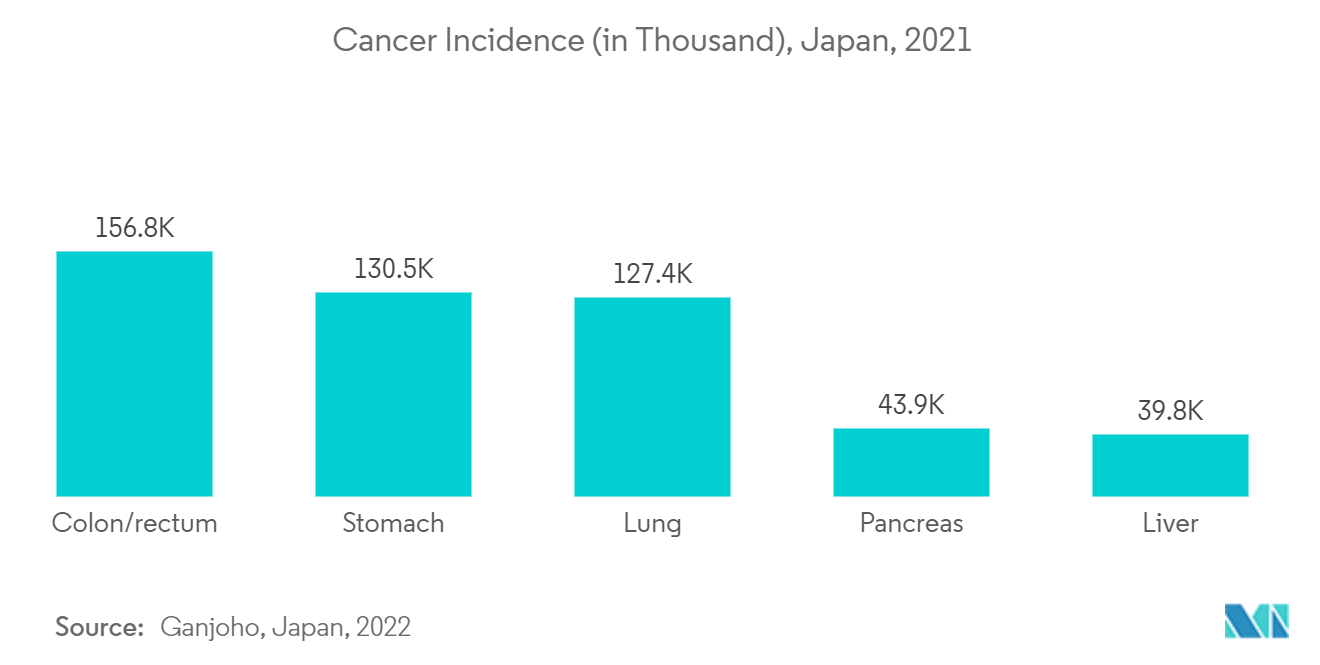Market Trends of Japan Nuclear Imaging Industry
Oncology Segment is Expected to Witness Significant Growth Over the Forecast Period
The oncology segment is anticipated to witness a significant share in the nuclear imaging market over the forecast period owing to the factors such as the growing burden of various types of cancer and the growing application of radioisotopes in treating and diagnosing cancer sites in the body.
The increasing prevalence of cancer is boosting the demand for radioisotopes for nuclear imaging for research purposes. For instance, as per the 2022 statistics published by Ganjoho, the lung was the leading site (24%) for males, followed by the rectum/colon (13%), stomach (12%), pancreas (8%), and liver (7%). In addition, as per the same source, the rectum/colon was the leading site for cancer among the female population (16%), followed by the lung (14%), pancreas (12%), breast (10%), and stomach (9%). Thus, the high burden of cancer and the need for early diagnostics are expected to increase, supporting the segment's expansion over the forecast period.
According to an article published in Europe PMC in January 2022, Japanese researchers observed that the use of artificial intelligence (AI) in nuclear medicine for oncology is increasing for various purposes such as assisted interpretation(computer-aided detection (CAD) or diagnosis, also AI provides information such as predicting genes and prognosis from images. This is anticipated to fuel the demand for nuclear imaging and medicines for treating various cancers, thereby contributing to the segment's growth.
Similarly, FDG (18 fluorine-2-fluoro-2-deoxy-d-glucose) is the radiopharmaceutical used in oncology PET (positron emission tomography), which shows the enhanced metabolism of malignant cells in comparison to normal cells. This technique can be used for the imaging of lung cancer, lymphoma, head and neck tumors, breast cancer, esophageal cancer, colorectal cancer, and urinary tract tumors.
Furthermore, the companies' rising focus on adopting various key strategies such as collaboration, agreement, and others are expected to increase research and development in the field of nuclear medicine, hence boosting the market's growth. For instance, in January 2021, Fuzionaire Radioisotope Technologies K.K. entered into a feasibility study agreement with Nihon Medi-Physics Co. Ltd (NMP), a Japan-based pharmaceutical company. Under the terms of the agreement, NMP evaluates the ability of Fuzionaire Dx's technology to create a new class of positron emission tomography (PET) radiopharmaceuticals.
Therefore, owing to the aforementioned factors, such as the high burden of cancers, growing technological advancements and the studied segment is anticipated to grow over the forecast period.

Equipment Segment is Expected to Have the Significant Market Share Over the Forecast Period
Nuclear imaging equipment is used in the diagnosis of diseases by using small amounts of radioactive substances in patients and is used in a wide range of medical applications, including cardiology, obstetrics/gynecology, vascular, urology, and other medical applications.
The factors attributing to the segment growth are the increasing burden of chronic diseases such as orthopedic disorders, neurological disorders, and others, as well as the growing technological advancements. For instance, an article published in the Journal of Orthopaedic Science, in September 2021, about 4,052 knee arthroplasties are expected to be performed on men between the ages of 40 and 64 years, 6,942 on men between the ages of 65 and 74 years, 14,986 on men over 75 years in Japan by 2030. In addition, as per the same source, about 7,092 knee arthroplasties are expected to be performed on women between the ages of 40 and 64 years, 22,957 on women between the ages of 65 and 74 years, and 58,340 on women over 75 years in Japan by 2030. Thus, the expected increase in the number of hip surgeries among the population increases the demand for nuclear imaging equipment to effectively diagnose loosening and infection after total hip replacement, hence bolstering the market growth.
Furthermore, the growing key strategies by the companies are also contributing to the segment's growth. For instance, in August 2021, Rigaku Corporation acquired all issued shares of MILabs BV as part of their full-scale effort to enter the life sciences business. Through this acquisition, Rigaku expands its life sciences modality business globally by combining MILabs' multi-modality businesses, including PET (Positron Emission Tomography), SPECT (Single Photon Emission Computed Tomography), Optical Imaging, and CT (Computed Tomography) equipment.
Therefore, owing to the aforementioned factors, the studied segment is anticipated to grow over the forecast period.


